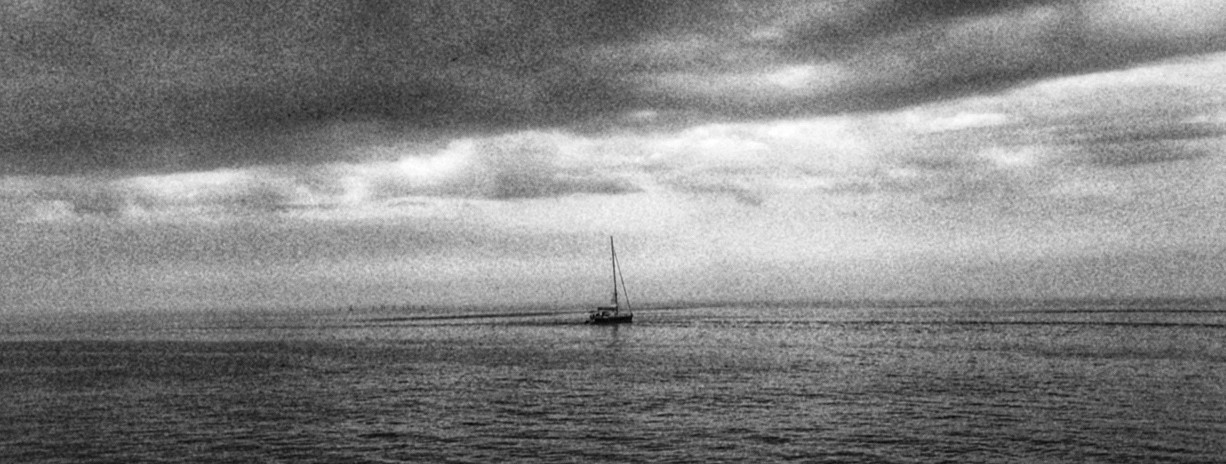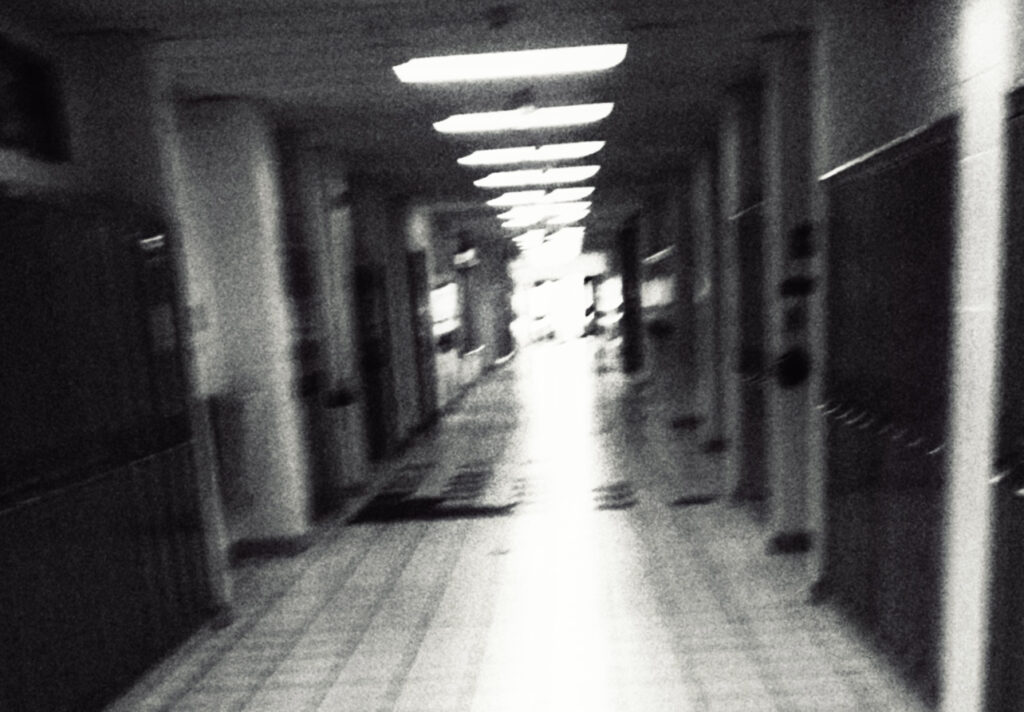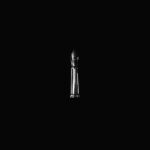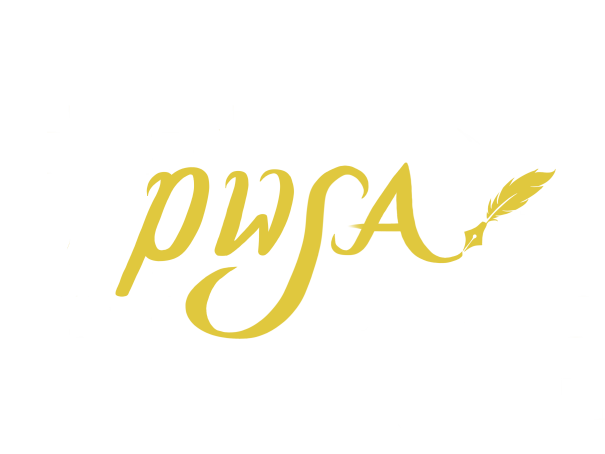ADRIFT

I fade through the brightly lit corridors with a cerulean slip in hand after escaping Functions & Applications, a Grade 11 math course that’s been ravaging me every night for weeks. The fawn-beige lockers are garrisoned on both sides of the tight, empty halls, blushing a shiny clam shell colour that mirrors an attenuated and distorted reflection of myself as I traipse by.
After drifting past a few cacophonous classrooms and two silent washrooms, I bump my forearm against the cold crash bar to lightly thrust open the door, uncloaking a stairway stitched to a scarlet and sandy brick wall on its right side.
I descend the tan-tiled staircase, my free hand gliding down the shiny wooden handrail hoisted up by dark crimson balusters made of steel. As I make my way to the guidance office, there’s a large question mark floating in my head, wondering why I’ve been summoned to one of the counsellors. It’s a first for me, and it only adds to the anxiety that’s been trailing me for months.
Once I slide into the office, I hand the slip to the middle-aged woman with a short black lob and curtain bangs at the front desk. She tilts her head up and peers at the print through her bold glasses for a few short seconds, although those seconds feel glacial. In a genial tone, she asks me to take a seat until the counsellor is ready to see me. I sit at one of the three cushioned chairs stationed by the exit, letting my eyes wander around the room. I haven’t noticed before — probably because I’m rarely ever in here — but I’m only now registering the room’s peculiar look.
The light maroon door is snuggled between two walls of panes, which almost resemble large grids that look like oversized tic-tac-toe boards. Between these glass barriers are flat, broad pillars made of smooth bricks, one of which is upheaving a cloudy clock just under the drop ceiling. The space is oddly laid out: creamy drywall behind the laminated reception desk, a wooden garden bench with an ornate iron backrest planted by the door, and a paddle board-shaped table by my seat wielding dozens of post-secondary brochures that flaunt stock photos of beaming students.
I pull down my sleeves before fidgeting with my hoodie strings, twisting and releasing, twisting and releasing. Just as my eyes graze over the generic office clock, which reads about 9 a.m., Ms. B steps out from the narrow corridor, her rectangular glasses matching the silvery shine of her pixie cut and dangling earrings.
She greets me with a wrinkled smile, although I’m unsure whether it’s a genuine display of ebullience or if she’s very effectively masking the early Monday blues.
Ms. B invites me to her office, so I follow her across the glossy flooring and into the cramped room containing shelves that are overflowing with binders, files, and paperwork.
Her fingers tapdance over her keyboard before her cursor whirls across her monitor. She pulls up my files — my grades and courses — and spins to me on her wheely chair. I see Advanced Functions and Calculus on her screen, two Grade 12 courses I’ve selected probably a few months ago for next year.
She skates over my current and past grades in math, and then questions whether those two courses are a good idea. I finished math in Grade 9 with an 88 and a 79 in the tenth grade — both applied classes, the “easier” versions of the courses. But right now, I’m floating around the high 60s in Functions & Applications.
“You’re setting yourself up for failure,” she tells me candidly, her voice turning flat. She urges me to reconsider my course selections.
Math was never my strong suit, I admit, although the business programs I want to get into for university require Advanced Functions and Calculus. She tells me that there are other programs in the field that don’t need those prerequisites for potential admission.
There’s other stuff I’m enchanted by, like the non-fiction research assignment I’m doing for English class that requires us to research, create a TED Talk-esque presentation, and design an infographic about a newsworthy topic, tasks that I’d chip away at every day after school. What’s unusual is that I don’t mind dwelling in these projects, minus the public speaking. I keep these sentiments concealed, afraid it would obstruct my goal of getting to where the faces in the stock images appear to be: in a successful program, equipped to make it in life.
For the past few months, I’ve heard chatter about finding a career path that pays well, contributes to society, and has a “good” reputation, which is seemingly the most crucial among the trifecta. There are crosshairs aimed at subjects deemed “unrealistic for the future,” like the arts, a philosophy I quickly adopted.
Internally, there’s a submerged sliver that acknowledges how I’m forcing myself to like the field of business, so much that it’s become an uncomfortably comfortable masquerade. Yet whenever the day wanes and I’m left nose-deep in a chapter on quadratic functions, I would blink through blurs and feel my teeth grit together.
My fingers find my hoodie strings again, swivelling them to look like those DNA structure illustrations you’d find in science textbooks. (Another subject I’d prefer to stray away from.) I shift in the cushioned seat. I think Ms. B is expecting me to say something, although my brain’s racked with tornadoes, over-replicating the convolution in her office.
It’s a rude awakening I should’ve seen coming. My weaknesses aside, if I didn’t diverge from this route, then it’d be an incessant cycle of nightly headaches for another year — and perhaps more. What’s worse is that I’ve been frozen in the role, intent on living the part.
So I impulsively agree. I tell Ms. B that I’ll drop the courses for something else.
It’s a rational decision, she says, although she wants parental consent before she’ll green-light the course alterations. She calls my mom, briefly glosses over the situation, and hands me the grainy textured phone sitting at the side of her desk. My mom doesn’t seem to mind, so she agrees and simply tells me to do what I think is best for myself.
Once everything’s approved, my timetable shuffles around and becomes a balance of classes I don’t mind dabbling in — English, Philosophy, and Indigenous Studies — and the path I initially intended to go down — Data Management, International Business, and Economics.
As I step out of the office and back into the main reception area, I grab a few brochures from the paddle board. The smiles in the stock images are vigorous contrasts to the room they’re caged in; I also hope to find solace despite feeling out of place.
━━━━━━━━━━━━━━━━━━━

The Functions textbook moulders on the side of my desk by sheets of equations and graphs. My monitor casts a blazing glow, a warm window of light that burns my eyes.
I spend that night sleuthing out different post-secondary programs, using the brochures as if they’re tour guides. Career quizzes, personality tests, and job boards are ingrained into my daily routine. Some don’t seem accurate at first, until I realize that I’ve wired myself to instinctively gravitate towards what fits the image I’ve projected for so long. Burrowing into this facade is muzzling how I recognize myself.
But it’s refreshing to deviate from parabolas and its sapping effects. As I’m searching for an escape, I wonder what would’ve happened if I never received that cerulean get-out-of-jail-free card. I likely would have still been deliberately misleading myself, bewitched by conformity’s caress.
Ms. B had given me advice: make a list of everything that genuinely enthralls me, stuff that I can see myself doing for a long time. So I sail through the web, creating a t-chart of programs that intrigue me in one section and areas to stray away from in the other.
After a while, I lean into my monitor and count the bullet points. The left side is adorned with fields that seem to have some sort of creative outlet: writing, journalism, and marketing. The other side is mostly filled with anything that math or science branches too far into, like accounting. The conundrum, now, is choosing “a new path,” the one to walk.
Searching for this big answer doesn’t feel right; every choice hazes with uncertainty. It’s as if we’re meant to choose one purpose at this age, that we’re heaved only by a singular, unchanging motive. But perpetuity sounds like a curse.
My eyes shut, teary from the prolonged exposure to blue light. The evening is still, humming with passing cars every few minutes. An old streetlight from across my house is shimmering a faint light towards me, too infirm to brighten my room.
A few minutes later, I swoosh my curtains shut and flick on my lights. I traverse the yeses and noes, which slowly unblur the act I’ve put up. Now that the route I was going to take is closed, it doesn’t feel like there’s a point in trying to wrap my head around factoring quadratic equations 24/7.
Clusters of smudged graph paper near my elbow are brandishing scribbles of blurry graphite, which are sprinkled over by eraser shavings. I take one of the cleaner pages and flip it over, revealing a blank canvas. I pick up my blunt Dixon pencil, which is nearing the end of its stubby life, and jot down some of the arguments in favour of vaccinations, the broad topic of my TED Talk assignment that I plan on sharpening.
The words sprawl throughout the page, inspiring me to log onto EBSCO to continue my research. As I continue digging, I’m reading articles about scientific progression and how knowledge accumulates over time.
Thinking ahead isn’t possible without considering the blocks that built us to this point and where we are now. In a bizarre way, I suppose our experiences aren’t much different. Being peripatetic — traversing multiple pathways — can scaffold into how we shape new directions. Knowing what doesn’t work, because of the experiences I’ve had, narrows a move towards my unmasking.
Periodically, I’d take breaks by scrolling through programs and flipping through brochures. Days of research turn into months. As my notes tower in my Word document, I let go of the brochures, seeing that they mostly fell on the right side of my t-chart. Business didn’t make it on my list, and never did.
━━━━━━━━━━━━━━━━━━━

Many months later, near the end of the first semester of twelfth grade, I’m yet again in another odd room. A set of hallways wrap around us in a way that makes the room feel like the centre of orbit. There’s rows of glass on three walls, which point toward other classrooms, while the fourth wall is shielded by a whiteboard that’s lit up by an overhead projector. The perimeter is lined with aging Dell and HP computers, all equipped with Internet Explorer. Much like the web, the day is sluggishly ticking by.
When the bell finally lets out its abrasive clang, my entire International Business class gets up to scurry out one of the two doors, congregating in the corridors with students leaving the classrooms across from us. I wait until everybody clambers out before taking off.
Students stampede down the stairs, racing to the front doors towards the winter snow. Meanwhile, I take my time descending the stairs before perambulating past the guidance office, getting a glimpse of the new slushes of brochures that are muddled in messy piles.
Large crowds inject themselves into the main hall, so I take a detour from the foot traffic by going around the back. As I’m passing by different sections of the school, I’m also walking by rooms that are grouped into larger departments. There’s the Business Hall upstairs that I just left, the adjacent Math Hall, and other corridors downstairs that contain subjects like Geography and History, which are areas that I also once disregarded. But that was when I was following instead of finding. It turns out that most of the noise I heard about pinpointing a suitable career was forged by my own mind, by a false depiction of what success “typically” looks like.
When I submitted three university applications less than two weeks ago — to media studies, journalism, and professional writing, all of which are at different universities in the same province — I realized the notes I wrote have helped me avoid misrecognizing myself.
I arrive at my locker, spinning the dial forwards, backwards, and then forwards again on its padlock, unlocking it and swinging the door open. I stuff my Data Management and Business textbooks inside for now, subjects that no longer feel like chains, no longer allies of pervasive brochures and their illusionary stock images. When they’re penned on the right side of the t-chart, they become a way of navigating.
After donning my obsidian jacket and slinging my light backpack over my shoulder, I seal my locker shut and wonder which offers of admission to accept. I received one for media studies and another for pro writing via email in the past 24 hours. Maybe another t-chart would help me decide. As I gaze at the reflection relayed by my locker, I accept that being adrift isn’t so bad, and neither is drifting in deviation. As long as there isn’t a mask obscuring my vision, wandering is fine.
Royce Luu (he/him) is a fourth-year Professional Writing student at York University with particular interests in journalism and book publishing. When he is not agonizing over words, he’s usually buried in a book, listening to metal, or editing friends’ cover letters.

